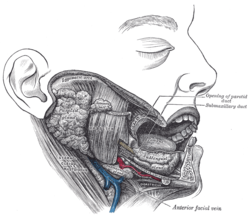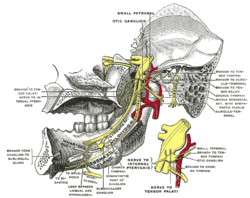| Submandibular duct | |
|---|---|
 Dissection, showing salivary glands of right side. (Labeled as "submaxillary duct", but is identified as "submandibular duct" in newer sources.) | |
 Mandibular division of trifacial nerve, seen from the middle line. The small figure is an enlarged view of the otic ganglion. ("Wharton's duct" labeled in lower left.) | |
| Details | |
| Location | below mouth |
| Source | submandibular gland |
| Drains to | mouth |
| Function | drains saliva from submandibular gland to mouth |
| Identifiers | |
| Latin | ductus submaxillaris |
| TA98 | A05.1.02.012 |
| TA2 | 2811 |
| FMA | 86266 |
| Anatomical terminology | |
The submandibular duct (also Wharton's duct or historically submaxillary duct) is one of the salivary excretory ducts. It is about 5 cm long, and its wall is much thinner than that of the parotid duct. It drains saliva from each bilateral submandibular gland and sublingual gland to the sublingual caruncle in the floor of the mouth.
YouTube Encyclopedic
-
1/3Views:1 12130 91625 734
-
Submandibular duct
-
Huge Sialolith from submandibular salivary gland.......Submandibular Salivary Stone removal,
-
3stones in the left Wharton's duct
Transcription
Structure

The submandibular duct arises from deep part of submandibular gland, a salivary gland. It begins by numerous branches from the superficial surface of the gland, and runs forward between the mylohyoid, hyoglossus, and genioglossus muscles. It then passes between the sublingual gland and the genioglossus and opens by a narrow opening on the summit of a small papilla (the "sublingual caruncle") at the side of the frenulum of the tongue. It lies superior to lingual and hypoglossal nerves.
Variation
The submandibular duct may be duplicated on one side or both sides, creating an accessory submandibular duct.[1][2] Rarely, it may not perforate into the mouth.[1]
Function
The submandibular ducts drain saliva from the submandibular gland, and the sublingual glands to the sublingual caruncles in the floor of the mouth[3]
Clinical significance
Sialolithiasis
The submandibular duct may be affected by stones, known as sialolithiasis.[4] These may grow large, requiring surgery to remove.[4] Simple palpation may be used to identify the location of any stones before surgery.[4]
Imperforate
Rarely, the submandibular duct may not perforate into the mouth.[1] Surgery may be used to repair this birth defect.[1]
Drooling
The exit of the submandibular gland into the mouth may be realigned in patients who drool.[5] This redirects the exiting saliva away from the vestibule and the lips.[5] This surgery has a fairly high success rate.[5] Rarely, the submandibular gland may need to be removed on one or both sides.[5]
History
The submandibular duct was initially described by the English anatomist Thomas Wharton ( 1614-73) and is sometimes referred to by his name.[6]
References
![]() This article incorporates text in the public domain from page 1135 of the 20th edition of Gray's Anatomy (1918)
This article incorporates text in the public domain from page 1135 of the 20th edition of Gray's Anatomy (1918)
- ^ a b c d Pownell, Patrick H.; Brown, Orval E.; Pransky, Seth M.; Manning, Scott C. (1 September 1992). "Congenital abnormalities of the submandibular duct". International Journal of Pediatric Otorhinolaryngology. 24 (2): 161–169. doi:10.1016/0165-5876(92)90142-C. ISSN 0165-5876. PMID 1428595.
- ^ Gadodia, A.; Seith, A.; Neyaz, Z.; Sharma, R.; Thakkar, A. (September 2007). "Magnetic resonance identification of an accessory submandibular duct and gland: an unusual variant". The Journal of Laryngology & Otology. 121 (9): e18. doi:10.1017/S0022215107008602. ISSN 1748-5460. PMID 17517164. S2CID 23010849.
- ^ Grewal, Jeewanjot S.; Jamal, Zohaib; Ryan, Jesse (2022), "Anatomy, Head and Neck, Submandibular Gland", StatPearls, Treasure Island (FL): StatPearls Publishing, PMID 31194412, retrieved 2022-11-20
- ^ a b c Raksin, S Z; Gould, S M; Williams, A C (1975-02-01). "Submandibular duct sialolith of unusual size and shape". Journal of Oral Surgery (American Dental Association. 33 (2): 142–145. ISSN 0022-3255. PMID 1054388.
- ^ a b c d Crysdale, William S.; White, Ann (1989-07-01). "Submandibular Duct Relocation for Drooling: A 10-Year Experience with 194 Patients". Otolaryngology–Head and Neck Surgery. 101 (1): 87–92. doi:10.1177/019459988910100114. ISSN 0194-5998. PMID 2502766. S2CID 1777182.
- ^ Wharton T (1656). Adenographia: sive glandularum totius corporis descriptio. London: Wharton. pp. 128–137.
External links
- Anatomy figure: 34:03-05 at Human Anatomy Online, SUNY Downstate Medical Center
- MedicalMnemonics.com: 329
